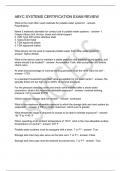DNA
The chromosomes in the nucleus store the genetic material of the cell.
The nucleus regulates the structure and metabolism of the cell.
Nucleic acids
Nucleic acids control the synthesis of proteins in all living cells by storing and transferring
genetic information.
Two types of nucleic acids:
- DNA (deoxyribonucleic acid)
- RNA (ribonucleic acid)
DNA (deoxyribonucleic acid)
DNA occurs mainly in the nucleus where it forms part of the chromatin network and it is known
as chromosomal DNA.
A small amount of DNA occurs outside the nucleus, in the mitochondria of plant/animal cells, as
well as in chloroplasts of plant cells. This DNA is known as extranuclear DNA.
DNA found in the mitochondria is known as mitochondrial DNA (mtDNA). It is passed from
mother to child and is thus used to trace maternal lines through generations.
As it rarely undergoes changes due to mutations and remains largely unaltered, it is very useful
in determining relatedness between individuals.
,Chromosomes and genes
Chromosomes are composed of DNA that is wrapped around proteins called histones.
A short segment of a DNA molecule that codes for a particular protein is known as a gene.
Each gene carries the code for the synthesis of a particular protein.
Proteins determine the characteristics (structure and functioning) of an organism.
A gene is a segment of a DNA molecule that controls an inherited characteristic and determines
the appearance and functioning of an organism.
Chromosomes are only visible in dividing cells.
Discovery of the structure of DNA
Scientists, James Watson and Francis Crick, formulated the double helix structure of DNA in
1953. In the early 1950’s, Watson and Crick were both doing postgraduate research in England
when they became involved in DNA research. The other team that was actively doing research
on DNA structure, was Maurice Wilkins and Rosalind Franklin in London. In 1952 they took
X-ray photographs of the DNA molecule. Franklin then surmised that DNA was helix-shaped.
Wilkins showed Franklin’s X-ray photograph to Crick without her permission. Watson and Crick
used the information from the X-ray photograph to build three dimensional models to solve the
structure of DNA. Franklin died of cancer in 1958, at the age of 37. In 1962, Watson, Crick and
Wilkins jointly received the Nobel prize for Physiology/Medicine for their discovery of the
structure of DNA.
Franklin was never honoured as the Nobel Prize is not awarded posthumously.
,Structure of DNA
DNA is a giant molecule, consisting of two strands that are twisted to form a double helix.
The total length of DNA in the nucleus of a human cell is approximately 2 metres.
DNA is a polymer made up of a large number of monomers.
These monomers are known as nucleotides.
Nucleotides
Each nucleotide consists of three parts:
- Sugar molecule (Deoxyribose)
- Phosphate group
- Nitrogenous base
- Adenine (A)
- Guanine (G)
- Cytosine (C)
- Thymine (T)
Adenine (A) and Guanine (G) are large molecules.
Cytosine (C) and Thymine (T) are smaller molecules.
Formation of DNA
- The deoxyribose of a nucleotide forms a bond with the phosphate group of another.
- Two long strands are formed.
- Sides of DNA ladder consist of alternating deoxyribose molecules and phosphate groups.
- Each rung of the DNA ladder is formed by the linking of two nitrogenous bases; one large &
one small base, forming a base pair.
- Nitrogenous bases are joined by weak hydrogen bonds, which are easily broken by enzyme
action.
, Nitrogenous bases combine as follows:
- Adenine (A) to Thymine (T)
- Guanine (G) to Cytosine (C)
Two hydrogen bonds form between Adenine and Thymine, and three form between Guanine
and Cytosine.
The following base pairs are formed:
AT GC TA CG
In any DNA molecule there are equal numbers
of (A) and (T) and as well as (G) and (C) bases.
The sequence of bases provides the code that
gives the instructions for protein synthesis.
This code is known as the ‘genetic code’ or the
‘code of life’.
The sequence of bases in one DNA strand (template) will determine the sequence in the other.
Role of DNA
Genes
DNA carries the genetic code (in the form of genes) for the synthesis of proteins.
A gene is a short segment of DNA with a specific sequence of nitrogenous bases.
This sequence of bases determines the sequence and type of amino acids that will combine to
form a particular protein.
DNA can replicate to ensure that the genetic code is accurately transferred from one
generation to the next.
The chromosomes in the nucleus store the genetic material of the cell.
The nucleus regulates the structure and metabolism of the cell.
Nucleic acids
Nucleic acids control the synthesis of proteins in all living cells by storing and transferring
genetic information.
Two types of nucleic acids:
- DNA (deoxyribonucleic acid)
- RNA (ribonucleic acid)
DNA (deoxyribonucleic acid)
DNA occurs mainly in the nucleus where it forms part of the chromatin network and it is known
as chromosomal DNA.
A small amount of DNA occurs outside the nucleus, in the mitochondria of plant/animal cells, as
well as in chloroplasts of plant cells. This DNA is known as extranuclear DNA.
DNA found in the mitochondria is known as mitochondrial DNA (mtDNA). It is passed from
mother to child and is thus used to trace maternal lines through generations.
As it rarely undergoes changes due to mutations and remains largely unaltered, it is very useful
in determining relatedness between individuals.
,Chromosomes and genes
Chromosomes are composed of DNA that is wrapped around proteins called histones.
A short segment of a DNA molecule that codes for a particular protein is known as a gene.
Each gene carries the code for the synthesis of a particular protein.
Proteins determine the characteristics (structure and functioning) of an organism.
A gene is a segment of a DNA molecule that controls an inherited characteristic and determines
the appearance and functioning of an organism.
Chromosomes are only visible in dividing cells.
Discovery of the structure of DNA
Scientists, James Watson and Francis Crick, formulated the double helix structure of DNA in
1953. In the early 1950’s, Watson and Crick were both doing postgraduate research in England
when they became involved in DNA research. The other team that was actively doing research
on DNA structure, was Maurice Wilkins and Rosalind Franklin in London. In 1952 they took
X-ray photographs of the DNA molecule. Franklin then surmised that DNA was helix-shaped.
Wilkins showed Franklin’s X-ray photograph to Crick without her permission. Watson and Crick
used the information from the X-ray photograph to build three dimensional models to solve the
structure of DNA. Franklin died of cancer in 1958, at the age of 37. In 1962, Watson, Crick and
Wilkins jointly received the Nobel prize for Physiology/Medicine for their discovery of the
structure of DNA.
Franklin was never honoured as the Nobel Prize is not awarded posthumously.
,Structure of DNA
DNA is a giant molecule, consisting of two strands that are twisted to form a double helix.
The total length of DNA in the nucleus of a human cell is approximately 2 metres.
DNA is a polymer made up of a large number of monomers.
These monomers are known as nucleotides.
Nucleotides
Each nucleotide consists of three parts:
- Sugar molecule (Deoxyribose)
- Phosphate group
- Nitrogenous base
- Adenine (A)
- Guanine (G)
- Cytosine (C)
- Thymine (T)
Adenine (A) and Guanine (G) are large molecules.
Cytosine (C) and Thymine (T) are smaller molecules.
Formation of DNA
- The deoxyribose of a nucleotide forms a bond with the phosphate group of another.
- Two long strands are formed.
- Sides of DNA ladder consist of alternating deoxyribose molecules and phosphate groups.
- Each rung of the DNA ladder is formed by the linking of two nitrogenous bases; one large &
one small base, forming a base pair.
- Nitrogenous bases are joined by weak hydrogen bonds, which are easily broken by enzyme
action.
, Nitrogenous bases combine as follows:
- Adenine (A) to Thymine (T)
- Guanine (G) to Cytosine (C)
Two hydrogen bonds form between Adenine and Thymine, and three form between Guanine
and Cytosine.
The following base pairs are formed:
AT GC TA CG
In any DNA molecule there are equal numbers
of (A) and (T) and as well as (G) and (C) bases.
The sequence of bases provides the code that
gives the instructions for protein synthesis.
This code is known as the ‘genetic code’ or the
‘code of life’.
The sequence of bases in one DNA strand (template) will determine the sequence in the other.
Role of DNA
Genes
DNA carries the genetic code (in the form of genes) for the synthesis of proteins.
A gene is a short segment of DNA with a specific sequence of nitrogenous bases.
This sequence of bases determines the sequence and type of amino acids that will combine to
form a particular protein.
DNA can replicate to ensure that the genetic code is accurately transferred from one
generation to the next.







